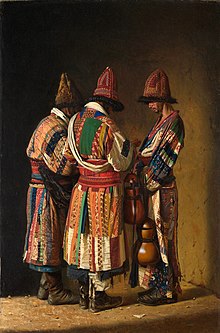Kalpak

The Kalpak , also Calpac , Kolpak or Kolpag , (from Proto-Turkish * kalbuk "high headgear", Turkish kalpak "(fur) hat"; furthermore Kazakh and Kyrgyz kalpak or qalpaq , Yakutian xalpaq ) is a tall, sometimes pointed or truncated cone Cylindrical hat mainly made of fur and / or felt for men, which is worn from Central Asia via the Caucasus and Turkey to the Balkans. From the Kalpak the Kolpak developed , a military headgear of the light cavalry, especially the hussars , or the light artillery.
The Turkish word has been adopted in a number of languages: Romanian calpac , Bulgarian and Serbian kalpak (калпак) mean "fur hat". The word came to Germany in the 17th century via the Polish kołpak , “high fur hat”. So the Kolpack in Danzig was a kind of women's hood . In Russian called Kolpak (колпак) the nightcap . The cylindrical Kolpik made of brown fur of some Hasidic rabbis (similar to the Schtreimel , only significantly higher) has the same name origin.
In several West Slavic languages, the word klobuk, which is related to kalpak, is the general name for “ hat ”, as in Slovak and Slovenian ; also klobouk in Czech , kłobuk in Polish Silesian , Klobyk in Lower Sorbian and Klobuk in Kashubian . In Russian, however, Klobuk ( Клобук ) only refers to the headgear of Orthodox clergymen.
While the Russian-Caucasian " Cossack " or " Tatar hat ", the papacha , is mostly made of lambskin , the Kalpak can consist of various types of fur and / or felt and often also has parts made of leather and cloth . However, there is some conceptual overlap. The high headgear made of Persian fur , the most precious type of lambskin that was popular in the Ottoman Empire and subsequent Turkey , was consistently referred to as Kalpak; likewise the karakul sheepskin hats , which were worn by aristocrats and Orthodox clergy in Greece and the Balkans in the 19th century. The very similar "kubanka", a cylindrical military headgear in the Red Army and in the Russian armed forces with a flat felt cover, is usually assigned to the papachas. The two Turkic-speaking ethnic groups, the Karakalpaks and Karapapachians, are named after their typical headgear: "black hats".
The forms of the kalpaks are just as varied. In winter, thicker, warmer ones are worn, in summer lighter ones, the brim or ear flaps of which can be folded up as sun protection. The front of the cuff is sometimes slit so that it forms two protruding points. In general, pointed, conical kalpaks predominate in Central Asia , while in Turkey high, frustoconical or cylindrical ones . Both shapes have in common that they can be folded flat when not being carried.
A manaschi, a Kyrgyz narrator of the national epic Manas with a typical regional kalpak
Coat of arms of Heidenheim an der Brenz , with a Heidenkopf
A simple Hungarian hussar (1703) with a pointed cap trimmed with fur
Mustafa Kemal Ataturk with a Kalpak made from Persian fur
Even in the " Bojarenmützen " from sable , mink and other wildlife pelts in tsarist Russia or Poland-Lithuania , there are rather high, rigid, cylindrical hats, alongside soft cap-like shapes. The latter found its way into Central European heraldry as a common figure through the Hungarian heraldry since the 16th century, under the designation Heidenhut (also called Tatar, Hungarian or Albanian cap) .
In the Hussaria , the heavy Polish cavalry of the 16th and 17th centuries, a wide variety of fur hats were also common, but mostly bearskin hats with hanging wings, or high kalpaks with plumes . From these, the actual hussar hat (Kolpak) developed from seal and otter skin with an overhanging cloth bag in the 18th and 19th centuries .
Characteristic of the ( dervishes ) of the Mevlevi , one of the many schools in Sufism , a mystical current in Islam, is the very high Kalpak felt. Its center and origin is in Konya in Turkey. But other schools can also be recognized by their typical headgear.
At the end of the 19th and beginning of the 20th centuries, the kalpak became part of the uniform of certain units in the Ottoman army. The Kalpak (especially made of Persian fur) was not only worn by high officers, but also in the civil upper class, initially also among politicians willing to reform ( Young Turks ) and around Mustafa Kemal Ataturk. In 1925, however, he had the Kalpak, along with other traditional headgear, banned by the Hat Act, as he viewed it as an expression of a backward-looking, outdated state of mind. Since then, the Kalpak has almost disappeared from all walks of life.
See also
Individual evidence
- ↑ Hans-Friedrich Foltin: The headgear and their designations in German . Inaugural dissertation, Phillips University Marburg / Lahn, Wilhelm Schmitz Verlag, Gießen, 1963; Pp. 91-93.
- ↑ Wolf-Eberhard Trauer: The story of the Karakul sheep . In: Das Pelzgewerbe 1963/3, p. 183.
- ↑ Eva Nienholdt: Fur in the war costume and uniform . In: Das Pelzgewerbe 1958/6, p. 274.






